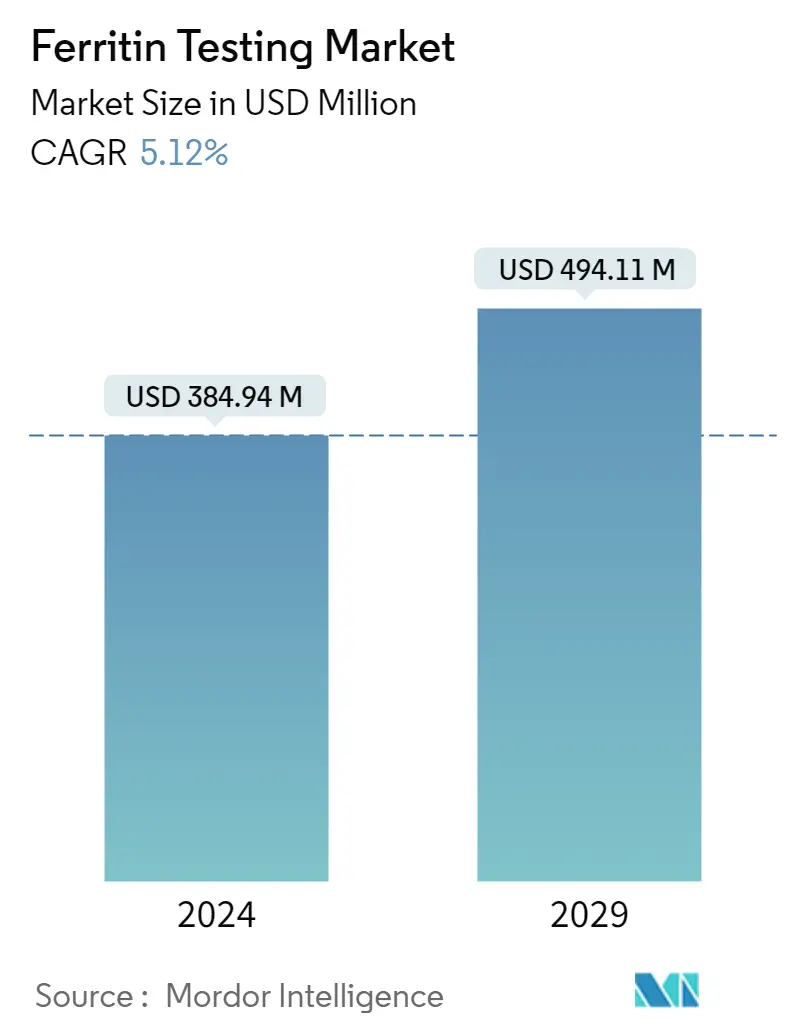Market Size of Ferritin Testing Industry

| Study Period | 2019 - 2029 |
| Market Size (2024) | USD 384.94 Million |
| Market Size (2029) | USD 494.11 Million |
| CAGR (2024 - 2029) | 5.12 % |
| Fastest Growing Market | Asia Pacific |
| Largest Market | North America |
| Market Concentration | Low |
Major Players
*Disclaimer: Major Players sorted in no particular order |
Ferritin Testing Market Analysis
The Ferritin Testing Market size is estimated at USD 384.94 million in 2024, and is expected to reach USD 494.11 million by 2029, growing at a CAGR of 5.12% during the forecast period (2024-2029).
The COVID-19 pandemic is expected to have a significant impact on the studied market owing to the factors such as a decline in the footfall in hospitals and clinics for other diseases diagnostics and treatment, the negative impact of COVID-19 on the management of other diseases, and lockdown restrictions. However, it was reported by several research studies that COVID-19 patient with anemia was at significantly higher risk owing to the life-threatening factor, which may have increased the demand for ferritin testing. For instance, according to a report published by the Journal of Anaesthesiology Clinical Pharmacology in September 2022, anemia is considered an independent prognostic risk factor for COVID-19. That hemoglobin can be used for risk stratification in patients under home or hospital care. Estimation of hemoglobin on admission can be used as a tool for risk stratification in the upcoming waves of COVID-19.
Meanwhile, a general public advisory to improve hemoglobin may be helpful in preventing severe COVID-19 infection in future waves. Hence, the use of ferritin tests may increase due to the link between severe COVID-19 and anemia. Thus, COVID-19 is expected to significantly impact the ferritin testing market.
The growing burden of iron deficiency disorders and the increasing burden of anemia in youngsters are expected to be major growth driving factors for the ferritin test market over the forecast period. For instance, according to a research study published in May 2022, titled "Global Prevalence of Anemia in Pregnant Women: A Comprehensive Systematic Review and Meta-Analysis," the overall prevalence of anemia in pregnant women was 36.8%, with moderate anemia having the highest prevalence of 70.8% and the third trimester having the highest prevalence of 48.8%. Also, as per the same source, the highest prevalence of anemia in pregnant women was found in Africa, where it was 41.7%. and due to pregnancy's economic, sociological, and health variables, anemia among pregnant women in developing countries is substantially higher than in developed countries. Hence, due to the high burden of anemia, the demand for ferritin test devices is expected to increase around the world, which is anticipated to fuel growth in the studied market.
Additionally, the higher prevalence of blood disorders in the geriatric population and their increasing population is expected to increase the burden of blood disorders on the world, which will further augment the demand for ferritin test devices, and the market is expected to grow. For instance, according to a research study published in May 2021, titled "Implementation of Geriatric Hematology Program for the Treatment of Older People with Hematological Malignancies in Low-Resource Settings," the number of adults 65 and older who have been diagnosed with a hematological malignancy will rise from roughly 600,000 in 2020 to almost 1 million by 2040, with the fastest growth occurring in areas with less developed economies. Further, according to the October 2021 report of the World Health Organization, the global population of people of age 60 years and more is expected to increase from 1 billion in 2020 to 2.1 billion by 2050. Thus, with the increase in the global geriatric population, the burden of blood disorders is further expected to increase, which is anticipated to boost market growth over the forecast period.
Therefore, due to the above-mentioned factors, the ferritin test devices market is expected to grow over the forecast period. However, the presence of an alternative transferrin saturation test is expected to restrain the growth of the studied market during the forecast period.
Ferritin Testing Industry Segmentation
As per the report's scope, the ferritin test is conducted for diagnosing iron deficiency disorders by measuring the level of iron in the blood. The Ferritin Testing Market is Segmented by Product Type (Instrument, Reagent, and Kits), Application (Anemia, Hemochromatosis, Lead Poisoning, and Other Applications), End User (Hospitals and Diagnostic Laboratories), and Geography (North America, Europe, Asia-Pacific, Middle East, and Africa, And South America). The market report also covers the estimated market sizes and trends for 17 different countries across major regions globally. The report offers the value (in USD million) for the above segments.
| By Product Type | |
| Instrument | |
| Reagent | |
| Kits |
| By Application | |
| Anemia | |
| Hemochromatosis | |
| Lead Poisoning | |
| Other Applications |
| By End User | |
| Hospitals | |
| Diagnostic Laboratories |
| Geography | ||||||||
| ||||||||
| ||||||||
| ||||||||
| ||||||||
|
Ferritin Testing Market Size Summary
The ferritin test market is poised for significant growth over the forecast period, driven by the increasing prevalence of iron deficiency disorders and anemia, particularly among pregnant women and the geriatric population. The COVID-19 pandemic has also played a role in shaping the market dynamics, as the link between anemia and severe COVID-19 outcomes has heightened the demand for ferritin testing. The market is characterized by a fragmented landscape with numerous global and regional players, including well-known companies such as bioMérieux SA, ThermoFisher Scientific, and Eurolyser Diagnostica GmbH. Despite the presence of alternative tests like transferrin saturation, the demand for ferritin tests is expected to rise due to the growing burden of blood disorders and the need for effective diagnostic tools.
North America is anticipated to hold a significant share of the ferritin test market, supported by a robust testing infrastructure and a high prevalence of blood disorders among its aging population. The United States, in particular, is expected to contribute substantially to the region's market share due to its extensive healthcare facilities and the necessity for regular anemia testing. The market's growth is further bolstered by initiatives such as the implementation of ferritin testing in blood donation programs and participation in health awareness events. These factors collectively underscore the market's potential for expansion, driven by both clinical needs and public health initiatives.
Ferritin Testing Market Size - Table of Contents
-
1. MARKET DYNAMICS
-
1.1 Market Overview
-
1.2 Market Drivers
-
1.2.1 Growing Burden of Iron Deficiency Disorders
-
1.2.2 Increasing Burden of Anemia in Youngsters
-
-
1.3 Market Restraints
-
1.3.1 Presence of Alternative Transferrin Saturation Test
-
-
1.4 Porter Five Forces
-
1.4.1 Threat of New Entrants
-
1.4.2 Bargaining Power of Buyers/Consumers
-
1.4.3 Bargaining Power of Suppliers
-
1.4.4 Threat of Substitute Products
-
1.4.5 Intensity of Competitive Rivalry
-
-
-
2. MARKET SEGMENTATION (Market Size by Value - USD million)
-
2.1 By Product Type
-
2.1.1 Instrument
-
2.1.2 Reagent
-
2.1.3 Kits
-
-
2.2 By Application
-
2.2.1 Anemia
-
2.2.2 Hemochromatosis
-
2.2.3 Lead Poisoning
-
2.2.4 Other Applications
-
-
2.3 By End User
-
2.3.1 Hospitals
-
2.3.2 Diagnostic Laboratories
-
-
2.4 Geography
-
2.4.1 North America
-
2.4.1.1 United States
-
2.4.1.2 Canada
-
2.4.1.3 Mexico
-
-
2.4.2 Europe
-
2.4.2.1 Germany
-
2.4.2.2 United Kingdom
-
2.4.2.3 France
-
2.4.2.4 Italy
-
2.4.2.5 Spain
-
2.4.2.6 Rest of Europe
-
-
2.4.3 Asia-Pacific
-
2.4.3.1 China
-
2.4.3.2 Japan
-
2.4.3.3 India
-
2.4.3.4 Australia
-
2.4.3.5 South Korea
-
2.4.3.6 Rest of Asia-Pacific
-
-
2.4.4 Middle East and Africa
-
2.4.4.1 GCC
-
2.4.4.2 South Africa
-
2.4.4.3 Rest of Middle East and Africa
-
-
2.4.5 South America
-
2.4.5.1 Brazil
-
2.4.5.2 Argentina
-
2.4.5.3 Rest of South America
-
-
-
Ferritin Testing Market Size FAQs
How big is the Ferritin Testing Market?
The Ferritin Testing Market size is expected to reach USD 384.94 million in 2024 and grow at a CAGR of 5.12% to reach USD 494.11 million by 2029.
What is the current Ferritin Testing Market size?
In 2024, the Ferritin Testing Market size is expected to reach USD 384.94 million.

